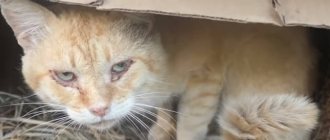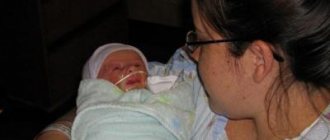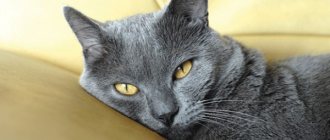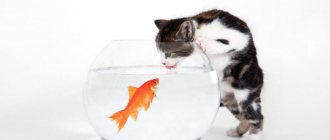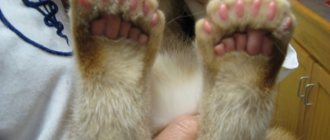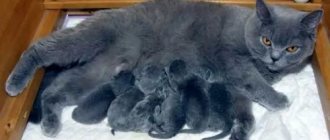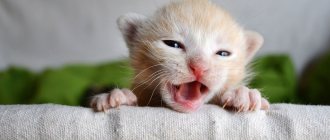It is recommended to study a description of the anatomy of a cat’s body with detailed pictures together with younger family members who are not particularly careful when handling the animal. They learn how fragile these pets are and how easy it is to harm them during active play.
Features of the structure of cats
Cats became pets much later than dogs. Therefore, they retained the body structure characteristic of all representatives of the cat family. The length of the body of a domestic cat varies within 60 cm, and the length of the tail is 25–30 cm. The average weight of a cat is 2.5–6.5 kg, but there are also impressive specimens weighing 7–9 kg. And cats of the Siberian and Maine Coon breeds can weigh 11–13 kg. There have been cases when cats reached 20 kg, but most often the reason for this was obesity.
On average, cats weigh up to 6.5 kg, but Maine Coons and Siberians can reach a weight of 13 kg
There are 4 parts of a cat's body:
- Head. It distinguishes between the brain (cat's skull) and facial (muzzle) parts. The front part also includes the forehead, nose, ears, and teeth.
- Neck. Here the upper part and the lower region are distinguished.
- Torso. It is represented by the withers (it is formed by the first five thoracic vertebrae and the upper edges of the scapula, which are on the same level with them), back, lower back, thoracic region (chest), croup, inguinal, abdomen, area of the mammary glands and prepuce, anal region, tail.
- Limbs. Thoracic (front): shoulder, elbow, forearm, wrist, metacarpus and pelvic (posterior): thigh, knee, shin, heel, metatarsus.
Animal spine
In the structure of a cat's skeleton, the longest element is the spine. It has incredible flexibility, which is due to the presence of tiny movable bones. This part of the cat's skeleton is formed from many vertebrae, divided into sections such as cervical, thoracic, lumbar, sacral and caudal. Each of them has certain characteristics and deserves special attention.
It is noteworthy that the tail is considered an integral part of the cat's spine. This organ is responsible for maintaining the animal’s balance during jumps and falls.
Cervical region
This section is formed by the larger 7 vertebrae, which are responsible for the support and mobility of the animal’s head. Two of them, called epistropheus (axial, axis) and atlas, are endowed with the unique ability to rotate 180 degrees. These vertebrae are connected to each other by a thin finger-like process.
Due to the increased fragility of such a connecting element, the epistrophy and atlas are considered the most vulnerable parts of the cat’s body, since when injured (impacts, falls from a great height), there is a high probability of damage to the process connecting them, which leads to a fracture of the cervical vertebrae and the death of the animal.
It is for this reason that experts do not recommend using a belt in this part of the cat’s body. Despite its flexibility, the cat's skeleton consists of several extremely fragile elements, which in some cases can be damaged. Under normal conditions, the animal's neck is completely safe. Unlike a belt, a flea collar is completely safe for such a pet.
Chest and ribs
This section of the cat's spine includes 13 vertebrae. 24 rib bones are attached to them on both sides. The first 5 pairs of ribs are called true, because they are attached to the sternum. The remaining ribs, which have an arched shape, are usually called false (false). Thanks to this structure of the rib bones, the flexibility of the animal’s body and its ability to turn around even in conditions of very limited space are ensured.
The structure of a cat's skeleton and its joints
The skeleton plays the role of a frame made of bones (a cat has about 240 of them) and has 2 sections: axial and peripheral.
The skeleton of a cat has about 240 bones
The axial section includes:
- The spine consists of 30 vertebrae, which are divided into 5 sections. The cervical vertebrae are large and allow the cat to turn its head almost 180 degrees without changing body position. The tail also belongs to the spine; it allows you to maintain good balance when jumping and falling.
The tail is part of the spine and helps maintain balance.
- The chest consists of 12 pairs of ribs.
- Cat skull. Unlike other mammals, cats have a short skull, and the size of the head in relation to the size of the entire body is small. Conventionally, the skull can be divided into 2 parts:
- facial, on which 13 bones are located;
- cranial, which contains 11 bones. The bones of the skull are stronger and larger than the facial part. The cat has a powerful jaw. Its main attribute is teeth. An adult animal has 30 of them. But even a kitten at the age of 3-4 weeks already has 26 sharp teeth. At 5–6 months, complete replacement of baby teeth with molars occurs.
Cats have shorter skulls than other mammals
The peripheral section includes the fore and hind limbs.
We all know that cats walk as if “on their toes”, without stepping on their heels completely. This is explained by the fact that the knee is located higher than we usually think - near the stomach.
There are 5 toes on each of the front paws, and 4 on the hind paws. Each toe ends in a sharp claw, hidden in a so-called pouch when at rest.
The cat only releases its claws when necessary.
Cat joints are divided into:
- sutures that form between the fused bones of the skull and consist of hard fibers, devoid of mobility;
- cartilaginous, which consist of durable cartilage; in cats, these compounds are more flexible and mobile than in other animals;
- synovial - these are connections between two or more bones, providing them with greater mobility, the main types of such connections: spherical,
- articulated.
Video: cat skeleton
What does a cat’s skeleton consist of: description of departments
The body structure of a domestic cat is divided into conditionally anatomical regions and parts. Body parts - neck, head, torso, limbs and tail.
A cat's spine is flexible and mobile
The physical abilities of these animals are amazing, they have no equal in jumping, balancing and the ability to crawl into narrow holes. And how many bones a cat has is influenced by the length of the animal’s tail. Its skeleton consists of bones, joints, tendons, and muscles that provide protection to the internal organs.
The cat's skeleton has an average of 250 bones and performs important functions:
- supporting Other organs rest on the bones and ligaments, tendons, and muscles are attached;
- motor. Bones, when muscles contract, move the body in space;
- The bones of the skeleton form cavities in which the brain and red bone marrow are located.
Sections of the kitten's skeleton:
- appendicular - limb bones;
- axial - bones of the skull, spine, ribs and sternum;
- visceral - the bones of the muzzle with the oral cavity and pharyngeal region with the intestinal tube.
For your information! The special structure of the cat's skeleton makes the animal an ideal predator.
Cat skull and teeth
The cat's head is short and round. The upper part consists of the cranial cavity, the frontal bone, which borders the crown. The nasal bone extends from it, ending in the upper jaw. The zygomatic bone of the cat's skull is clearly expressed from the side, the eyes rest in the sockets. The lower jaw is the only bone of the muzzle that is movably connected by a joint in the area of the temporal bone to the cat's skull. It has a body and branches. On the incisal and buccal parts, a dental edge is distinguished, in the sockets of which the teeth are located. Between the branches in the intermaxillary space there is the hyoid bone, on which the pharynx, larynx and tongue are located.
Note! The structure of the skull and the general appearance of the head are distinctive features of the breed.
At birth, kittens have no teeth. After about 2 weeks, the first milk teeth begin to appear - incisors, then canines, and only then the molars erupt. By the first month of life, the kitten already has 26 teeth: 12 on the lower jaw and 14 on the upper. The root of the tooth is deeply attached to the jawbone, which is covered by gums. The sensitive area is the transition from the gums to the visible crown of the tooth.
There are only 30 teeth in a cat's jaw: 16 on top and 14 on the bottom. Of them:
- 4 fangs;
- 12 incisors;
- 10 premolars;
- 4 molars.
You can determine the age of a cat by its teeth:
- 1 year - 30 snow-white, healthy teeth;
- 1.5 years - yellow discoloration appears on the teeth;
- 2 years - the lower middle incisors begin to wear off, the yellowness becomes more noticeable;
- 5 years - noticeable wear of fangs;
- 8 years - wear of the upper and lower incisors.
Cats are carnivores and their main prey are smaller animals. Therefore, all the teeth are quite sharp and easily cut meat.
Shoulder girdle
Another place in a cat's body where muscles are important is the shoulder girdle. Animals do not have a stabilizing clavicle, only a vestigial one. The shoulder blade articulates with the humerus, and the shoulder is held in place by muscles attached to the spine and sternum. Additional muscles in a cat's shoulder are the deltoids.
Note! The absence of a collarbone ensures a soft landing when jumping.
Torso bones
The skeleton consists of more than 33 vertebrae, divided into 5 sections. 7 cervical vertebrae form the neck. The thoracic region has 13 vertebrae, to which 12 pairs of ribs are attached. 7 lumbar vertebrae make up the lower back, 3 sacral vertebrae connect to the pelvic bones. The tail has from 19 to 23 vertebrae.
Thorax: how many ribs does a cat have?
A cat's chest is formed by ribs and thoracic vertebrae. The animal has 9–10 pairs of load-bearing ribs, connected to the sternum by cartilage, and 2–3 pairs of so-called false ribs.
Upper spine
The upper spine consists of 7 cervical vertebrae. Their function is to make the head mobile and support it. The name of the first vertebra is atlas, the second is epistropheus. They are connected by a thin process, which is most often susceptible to injury.
Upper spine
Small of the back
The lumbar region consists of the largest vertebrae, there are 7 of them, and the closer they are to the tail, the larger they are. They have large protrusions on the sides. Muscles are attached to them, the task of which is to hold not only the hind limbs, but also all the organs located in the abdominal cavity. A distinctive feature of this section is its flexibility, so the cat can easily curl up and roll over.
Sacrum
The sacral region is represented by one bone - the sacrum. The last lumbar vertebra is connected to it. During landing, the sacral disc is the fulcrum that provides the jump.
The cat's pelvis is formed by two nameless bones, the sacrum and the first caudal vertebrae. Each innominate bone consists of three others: the ilium, pubis and ischium.
Limb structure
The cat's hind limbs are much longer than the front, which allows the animal to jump high and run fast.
The girdle of the forelimbs (shoulder girdle) has its own characteristics. For pets, elastic attachment of the forelimbs is important, so they do not have a collarbone, and the front legs are attached with the help of ligaments and muscles.
Cats have 5 toes on their forelimbs. The last phalanx of each is the basis for the claw. The structure of a cat's paw is especially curious because the claws can extend or retract.
Limb structure
The shoulder girdle is represented by:
- spatula;
- humerus;
- radius and ulna bones.
- hand, which consists of the wrist, metacarpus, and phalanx of the finger.
The girdle of the hind limbs is rigidly attached to the sacrum. It includes:
- pelvic bone;
- femur;
- tibia and fibula;
- tarsal;
- mold, to which the phalanges of the fingers on the hind legs are attached, there are 4 in total.
For your information! The cats' elbows bend back, knees forward. Due to this structure of the limbs, animals jump and climb trees perfectly.
Tail
A cat's tail has between 19 and 23 vertebrae, which is about 10% of the total number of bones in the body. An extensive group of muscles, ligaments and tendons hold the tail in place and provide its amazing mobility.
Note! The average length of a cat's tail is 25 cm, and that of a cat is 23 cm.
The tail plays an important role in the life of a cat:
- helps balance when climbing, jumping and falling from heights;
- is an indicator of a cat's mood;
- sedative.
Cats wrap their tail around themselves, thereby retaining warmth, and it can also serve as a toy.
A cat's tail is a mood indicator
Any cat can become tailless or short-tailed due to injury, but this will not stop her from looking graceful and attractive.
Muscular system
A cat's musculature consists of 500 muscles. This amount provides the animal with grace and mobility. Cats can make long jumps and run at high speeds. The muscles are controlled by the brain. It is from him that they receive a signal for relaxation or tension.
The muscles are controlled by the brain in the body
Muscular system
Cats have an unusually developed muscular system. This is proven by their amazing jumps over fairly long distances and fast running. Also, a set of muscles helps the cat maintain its aristocratic bearing.
Thanks to its developed muscular system, a cat is able to perform amazing movements.
In total, a cat has about 500 muscles. They can be divided into 3 categories:
- heart muscle;
- smooth muscles, which control internal organs and work involuntarily;
- striated muscles that the cat controls itself.
Special fibers are part of all muscles. Cat muscles contain 3 types of cells:
- are strongly contracted, but work for a short time - thanks to them, the cat is able to jump long distances; the strength of these cells is not able to act for long;
- with a strong contraction they work for a long time - a cat has few such cells, which explains its inability to run long distances;
- they contract quietly and work for a long time - this type of muscle cells is used in a cat when hunting, when it sits in ambush for a long time, and also sneaks quietly and gently.
When hunting, a cat uses muscle cells that can work for a long time
The structure of the shoulder girdle has a peculiarity: the muscles connect the forelimbs and the torso, while in humans they are connected by the collarbone. In cats it is in its infancy.
To take a step, the cat pushes off with its hind paws, and the front paws participate in the braking process. Thanks to the elasticity of the back muscles, the cat can easily curl into a ball and assume other bizarre poses.
Leather and wool
The skin and coat protect the cat’s body from external influences: germs, overheating and hypothermia.
The cat's skin protects the body from harmful environmental influences
There are two main layers in a cat's skin:
- Epidermis is the top layer of skin.
- The dermis, inside which there are blood capillaries, hair follicles, nerve endings that transmit signals, as well as sebaceous glands that respond to nerve signals. Each hair follicle has its own sebaceous gland, which produces sebum, which gives the coat its shine. Special sebaceous glands are located in the anus and between the fingers; they produce pheromones. The sebaceous glands located on the face serve the cat to mark its territory.
Cat hair has special cells called cuticles. They reflect light, giving the coat a healthy shine. Therefore, dull fur on an animal always indicates problems in the body. The hair follicle has an erector muscle, which is capable of lifting the animal's fur, for example, in case of severe fear or hypothermia.
Cats' fur is raised by the erector muscle.
Cat hair has a tactile function. Whiskers located on the face, throat and front legs of cats are called whiskers. They are clearly visible on the animal's body. There are also small hairs - trilotiches, which are scattered on the surface of the animal's body.
Anatomical features
Dog skeleton: skull anatomy, structure of ribs and internal organs
The cat is the perfection of nature. She has no equal in the variety of physical capabilities. Cats masterfully jump, climb, balance, run, and react with lightning speed to danger. The most important part of a cat's body is its internal organs. The relationship between the nervous system and muscle performance makes the pet an excellent hunter.
Digestive system
The digestive system consists of organs responsible for processing food. Food enters the mouth and passes through the esophagus, stomach, small and large intestines before passing through the anus as solid waste.
The digestive system is structured almost the same as in humans
The system includes:
- mouth;
- teeth;
- language;
- salivary glands;
- esophagus;
- stomach;
- mucous membranes of the stomach;
- small intestine;
- large intestine;
- pancreas;
- liver;
- gallbladder.
Digestion of food occurs in 2 stages:
- mechanical. Food is crushed by teeth;
- chemical. Food is broken down into nutrients, which are absorbed into the blood through the walls of the small intestine.
Sense organs
The animal body has five sense organs: visual, equilibrium-auditory, olfactory, gustatory and tactile. Each of these bodies has departments:
- peripheral (perceiving) - receptor;
- middle (conductive) - conductor;
- analyzing (in the cerebral cortex) - brain center.
A cat's senses are a miracle of nature.
Features of the senses:
- the shape of the ears allows the cat to direct sound into the funnel. The ear tubes are lined with fine hairs that pick up sound vibrations;
- the sharpness of taste depends on the Jacobson's tube, which is also an organ of smell, which allows the animal to avoid accidental poisoning;
- cats have a very good sense of smell as they have 70 million olfactory cells inside their nose. Every contact with another living creature involves preliminary sniffing;
- Cats have a very well developed sense of touch. Most of the skin surface does not feel contact with hot surfaces at all, but the upper lip and nose are very sensitive. They receive signals and information from even the slightest air fluctuations;
- the animal moves its whiskers due to the presence of short small muscles located at the very roots.
Pets have vision, hearing, smell, touch and taste. This allows them to recognize smells, hear noises over long distances, and see in the dark.
Circulatory system
An important organ of the circulatory system is the heart, which is a muscle weighing 0.6% of the animal’s weight. It drives blood through two circles of blood circulation. Moving through the arteries and capillaries, the blood is saturated with the products of cellular activity and carbon dioxide, enters the veins and is sent through the heart through the second (lesser) circulation.
For your information! A 4 kg cat has approximately 0.2 liters of blood. Its composition and characteristics are still poorly studied. Veterinary medicine has described cases where a cat was not affected by doses of snake venom, even many times greater than lethal doses for other living beings.
Reproductive system
The reproductive system of cats is a set of organs and processes in the body aimed at the reproduction of offspring. It develops over a long period of time and varies by gender. The internal structure of a cat differs from the structure of a cat in its reproductive system. Outwardly, this manifests itself in the fact that in cats the scrotum is located just below the anus, in cats there is a slit-like vagina (vulva) in this place. Cats reach sexual maturity at 6-8 months. This means that the animal reaches physiological maturity and can be used for reproduction.
Depending on the breed, maturity appears at the age of 10 months to 1.5 years. To get full-fledged offspring, mating can only be done from this age of the pet. X-rays are used as an additional measure to monitor late pregnancy in cats.
Nervous system
The internal organs of cats are located in the same way as those of other mammals, have almost the same structure and perform similar functions.
The nervous system is responsible for transmitting messages to and from the brain and spinal cord. The spinal column is protected by bony dorsal vertebrae.
The nervous system is structured the same as that of all other mammals
The nervous system is divided into two parts:
- central. Consists of the brain and spinal cord, which are protected by a bony membrane: the skull (brain) and the spine (spinal cord);
- peripheral. Consists of nerves that connect the central nervous system with other parts.
The nervous system of cats, both central and peripheral, is well developed and functions properly. Activity is carried out using the senses: hearing, vision, smell, taste and touch. Fully develops as the kitten matures.
Respiratory system
The anatomy of a cat is not much different from other mammals. This also applies to the respiratory system, which is responsible for bringing oxygen into the body and removing waste in the form of carbon dioxide.
The system includes:
- nose;
- pharynx;
- larynx;
- trachea;
- bronchi (small airways);
- lungs.
The lungs have the shape of a truncated cone, the apex of which is located in the area of the first ribs, and the base is concave and corresponds to the dome of the diaphragm.
Brain and endocrine system
The brain is a mass of soft, pinkish-gray nervous tissue divided into three main sections:
- brain stem;
- brain;
- cerebellum.
A cat's brain consists of a billion neuron cells, and each cell has up to 10 thousand connections with other cells. The brain occupies 0.9% of the total body weight.
The brain occupies 0.9% of the total body weight
The endocrine system is responsible for the endocrine gland to regulate the body. It includes:
- hypothalamus;
- pituitary;
- thyroid gland;
- parathyroid glands;
- adrenal glands;
- part of the gastrointestinal tract;
- pancreas;
- kidneys;
- liver;
- ovaries and testes.
The endocrine system is distributed throughout the body as follows:
- the hypothalamus is located at the base of the brain;
- The pituitary gland is located at the base of the brain and is attached to the hypothalamus through a stalk-shaped cartilage;
- The thyroid gland is located in the neck below the larynx (voice box);
- there are two parathyroid glands located in the neck, closely related to the thyroid gland;
- there are two adrenal glands located in the abdominal cavity just in front of the kidneys;
- the gastrointestinal tract (GIT) is located in the abdominal cavity;
- pancreas in the front of the abdominal cavity, behind the liver and stomach;
- the liver is located in the front of the abdomen just behind the diaphragm;
- the ovaries are located in the middle part of the abdominal cavity next to the kidneys;
- The testicles are placed in the scrotum.
Leather and wool
Skin and hair cover the cat's entire body. The skin protects the muscles, skeleton and internal organs. Hair is located on the outer part of the skin.
Skin consists of:
- outer cellular layer;
- an avascular layer called the epidermis;
- inner fibrous corium, or dermis.
The epidermis is the body's shield. It consists of hard, keratinized cells. The dermis is made up of connective tissue that contains nerves, blood vessels, hair follicles, sweat and oil glands.
From each follicle in cats, two types of hairs grow: covert (awn) and secondary - downy.
A cat has four different types of hairs:
- The undercoat is the hairs closest to the skin. Their diameter does not change from root to tip. The main function is to protect the body from cold;
- guard hairs form the middle layer of the coat. They are bristly with a slight expansion in front of the tip;
- The protective coat forms the top coat and protects the undercoat and midcoat from external influences. It tapers evenly from root to tip;
- vibris - long, stiff and sensitive hairs that are used as organs of touch. These are mustaches, hair on the cheeks, chin, eyes and on the wrists of the front paws.
The camouflage function is manifested in the variety of shades of wool.
For your information! The sebaceous glands secrete fat rich in vitamin D.
Cat reproductive system
The reproductive system is an organ system designed for reproduction.
How does the genitourinary system work?
This system in a cat includes:
- the ovaries are responsible for childbirth by producing follicles;
- the tubes serve as a place for fertilization of the egg, creating a favorable environment for this;
- vulva is a general term that refers to all female genital organs located externally;
- The uterus is created for the development of the embryo and its birth.
Occurring ovulation provokes the cat to mate.
Anatomy of the cat's reproductive system
In cats, two testes (testicles) are located in the scrotum, which is located below the anus. The testes produce sperm, which pass through a system of efferent tubules into the epididymis (epididymis), where they are stored.
The cat managed to preserve the behavior pattern inherent in its wild ancestors; it hunts almost as well. The skeleton, muscles and nerves are designed for sudden sharp movements and jumps, an ideal sense of balance allows her to climb high and live in three dimensions. The digestive system is capable of digesting food, and the secretions are used to communicate with other cats. Thanks to the structure of the brain, a cat is able to learn throughout her life, and her unique senses help her in this.
Respiratory system
Breathing provides the body with oxygen and also gets rid of excess water.
The cat's respiratory system is similar to most mammals.
Respiratory organs include:
- Nose. The inhaled air enters the nasal cavity, where mucus is contained, which traps small dust particles, hairs and bacteria and prevents them from penetrating into the lungs.
The nose traps inhaled dust particles, hairs and bacteria
- The nasopharynx is the part of the pharynx through which air continues to flow further along the respiratory tract.
- The larynx is a cartilaginous tube that seals the airways when swallowed.
- The trachea is a cartilaginous tube that carries air into and out of the lungs. It runs from the larynx to the heart, where it divides into 2 bronchi.
- The lungs are the key organ of the respiratory process. The lungs are divided into left and right lobes. The left lung still has an additional lobe, so its size is slightly larger. The lungs contain blood and respiratory vessels. The trachea is divided into bronchi in the lungs, the bronchi are divided into bronchioles, and these, in turn, are divided into alveoli - small air bubbles that transmit oxygen to the blood vessels. Parenchyma is a collection of various vessels in the lungs.
- The diaphragm is a muscle that allows the lungs to expand.
The very process of a cat's breathing can be described as follows: under the action of the pectoral muscles and diaphragm, the lungs expand and pull air through the nasal cavity into the respiratory tract until it reaches the alveoli, which come into contact with the blood vessels and saturate them with oxygen, while at the same time removing carbon dioxide from them.
general characteristics
Our dogs (Canis lupus familiaris) and domestic cats (Félis silvéstris cátus) belong to the canine and feline families of the same class of mammals. All of them are carnivorous predators, actively obtaining food. These companion animals live an average of 7 to 14 years. The size of dogs varies greatly depending on the breed. With cats, everything is a little simpler - they weigh on average up to 4.5 kilograms and at the withers reach sizes of up to 25 centimeters.
These predators carry their young for about 2 months, feed them milk and sometimes show amazing care for their offspring.
There are many books and manuals on the maintenance, care, and nutrition of our pets. There are many more such books regarding dogs, which is associated with the development of service dog breeding. One of the best works on the anatomy and physiology of dogs (K. S. Stogov) is contained in all instructions for the training and education of service dogs.
Cats didn’t become service cats, but that doesn’t make people love them any less. Existing atlases of anatomy and physiology in pictures of dogs and cats provide a complete understanding of the similarities of these animals.
Circulatory system
The cat's circulatory system includes the heart and vessels that carry blood throughout the body:
- arteries are vessels through which blood flows from the heart to the organs; they are saturated with oxygen;
- veins - vessels through which blood flows from organs to the heart, are saturated with carbon dioxide;
- capillaries are small vessels that ensure the exchange of substances between tissues and blood.
The heart is a special muscle that regulates the movement of blood through the vessels. A cat's heart weighs 16–32 g, is four-chambered and has 2 halves, each of which has an atrium and a ventricle. The left side is responsible for arterial circulation, and the right for venous circulation. The systemic circulation originates in the left ventricle and passes into the right atrium. The small circle comes from the right ventricle, which ends in the left atrium, then passes into the left ventricle, starting the large circle again.
Pulse - compression and weakening of blood vessels in time with the rhythm of heart contractions. On average, in cats it reaches 130–140 beats per minute and can vary depending on the emotional and physical state of the cat.
You can feel your cat's pulse on the artery located on the inside of the thigh.
A cat has a unique blood composition, and the blood of other mammals is not suitable for it. There are three blood groups: A, B, AB.
The liver and spleen produce blood cells. The majority of the blood composition is occupied by yellow plasma, 30–40% by erythrocytes, and the rest by leukocytes and platelets.
Cat anatomy: structure of internal organs
The anatomical structure of a cat is close to humans and other mammals. Despite this, each animal has its own characteristics that distinguish it from other species.
Heart, blood and vessels
The heart is responsible for saturating cells with oxygen. This important muscle consists of 4 sections: 2 atria and 2 ventricles. On average, the heart rate is 130-140 beats per minute.
Calculating your pet's pulse is quite simple. To do this, you need to find the artery on the inside of the thigh.
The circulatory system includes 3 types of vessels:
- arteries saturated with oxygen;
- veins that carry carbon dioxide;
- capillaries that regulate metabolism and deliver blood directly to the organs.
The composition of any blood includes plasma and blood cells (platelets, erythrocytes, leukocytes). The uniqueness of cat blood lies in the fact that it is divided into only 3 groups: A, B and AB. They are taken into account when diluting and transfusing, since not all of them are compatible with each other.
The nervous system and its “ruler” – the brain
The nervous system regulates the animal's behavior. It consists of 2 departments:
- Central
. Includes the brain stem, spinal cord and brain. Responsible for reflexes (breathing, swallowing) that arise as a result of reactions to internal and external stimuli.
- Peripheral
. Includes cranial and spinal nerves. Connects the central nervous system with the organs of the body and is responsible for conducting nerve impulses. Thanks to the work of this department, conscious actions are carried out: releasing claws, licking and moving in space.
Each part of the brain performs a specific function. The occipital lobe is responsible for vision and touch, the olfactory bulb is responsible for smell perception, and the temporal lobe is responsible for memory.
The gastrointestinal tract is the main system, according to the cats themselves
The digestion process begins immediately after swallowing food. In the mouth, pieces of eaten food are softened by saliva and teeth. This makes it easier for them to pass through the pharynx and esophagus.
The environment in a cat's stomach is more acidic than a human's, so it easily processes the coarse fibers of raw meat. Problems arise only with carbohydrates, so your furry pet’s diet should not contain a lot of cereals.
Products broken down into water, proteins, fats and carbohydrates move to the duodenum and small intestine. Some of the nutrients are absorbed into their walls, and unprocessed residues are compacted into the feces and exited through the rectum.
Breathe and purr
The cat's body is supplied with oxygen through the respiratory system. It includes:
- nasal cavity, which cleans the inhaled air of dust and bacteria;
- pharynx, which provides additional filtration, warming and humidification of the air;
- the larynx, which regulates the volume of incoming oxygen and protects the trachea from food ingress;
- trachea - a special tube that regulates the flow of oxygen and the removal of carbon dioxide;
- the lungs are the main respiratory organ responsible for the process of gas exchange;
- the diaphragm, which controls the process of contraction and expansion of the lungs.
Whiskered pets breathe more frequently than humans and dogs. At rest, they take 20-30 breaths per minute.
In addition to the respiratory function, the larynx is responsible for the production of sounds. Thanks to her, animals meow.
With purring everything is more complicated. The mechanism of its appearance is explained by several theories, but most scientists are inclined to vibration of the hyoid bones.
How is a cat different from a cat?
The internal structure of a cat and a female cat are largely the same, but their genitals are different from each other. The male reproductive system consists of:
- testes;
- vas deferens;
- prostate;
- scrotum;
- penis.
The testes are responsible for the production of testosterone and sperm maturation. Through the ducts, sperm enters the penis and exits, allowing you to conceive offspring. With age, its quality deteriorates, but only castration can stop its production.
Bearing kittens is carried out exclusively by females, whose reproductive system is represented by:
- bicornuate uterus;
- cervix;
- vagina;
- ovaries;
- fallopian tubes;
- vulva.
The ovaries are an analogue of the testes. They are responsible for the production of female hormones and the maturation of eggs. Fertilization is possible only during estrus, so the most effective way to protect against unwanted pregnancy is timely sterilization.
Cats also go to the toilet...
The cat's urinary system consists of 4 organs: the urethra, bladder, ureters and kidneys. Urine enters the urethra only after careful filtration in all other sections. At the exit, it becomes secondary, as it loses some of its impurities.
Cats go to the toilet 2-3 times a day. The color of their urine is light yellow, and any change in shade indicates pathology. Due to the narrow urethra, males often suffer from blockage of the urethra by hard formations. As a result of injury to the walls of the bladder, the shade of urine changes to bright orange, brown or red.
Digestive and excretory systems
The digestive system regulates the process of eating, absorbing nutrients and eliminating undigested residues.
The organs of the digestive system are involved in the process of digesting food
The digestion cycle is carried out per day. This process involves:
- oral cavity;
- pharynx;
- esophagus;
- stomach - the pH environment in the stomach is more acidic than in humans, which allows it to digest rough food and fight bacteria in the food;
- small intestine, in cats it is short and does not allow carbohydrates to be digested well;
- colon;
- liver;
- kidneys
The process of digestion begins in the mouth as soon as food enters it. The salivary gland softens hard food, facilitating its passage into the stomach and esophagus.
The process of digesting food begins in the mouth
Under the influence of saliva, food begins to break down in the mouth. The complete food processing process takes place in 4 stages:
- The fundus of the stomach contracts, pushing the contents toward the pylorus.
- The contents of the stomach enter the duodenum in the following order: liquid, carbohydrates, proteins, fats.
- Food passes through the small intestine where nutrients are absorbed.
- Food debris enters the large intestine, and feces are formed and excreted.
A cat's stomach is constantly active. The cat usually eats often, but little by little (10–16 times).
Brain and endocrine system
Anatomically, a cat's brain is similar to the brain of any mammal.
The structure of a cat's brain is similar to that of any mammal.
Different parts of the brain are responsible for one or another function in the body:
- the parietal lobe processes information received through the senses;
- the large brain is responsible for consciousness;
- the corpus callosum connects the right and left hemispheres;
- the frontal lobe is responsible for voluntary movements;
- the olfactory bulb is responsible for the perception of smells;
- the hypothalamus secretes hormones and controls the autonomic nervous system;
- the pituitary gland coordinates and controls the work of other glands;
- the spinal cord transmits information from the brain to the body;
- the pineal gland is responsible for sleep and wakefulness;
- the cerebellum controls movements and muscle function;
- the temporal lobe is responsible for behavior and memory;
- The occipital lobe receives visual and tactile signals.
The endocrine system influences the basic functions that occur in the body with the help of hormones. Most hormones are secreted by the pituitary gland and hypothalamus. Also some of them are produced by the thyroid gland, adrenal glands, ovaries in cats and testicles in cats.
The endocrine system influences the body's basic functions
Table: hormonal regulation of cat body functions
| Hormone name | Where is it produced? | Functions |
| Antidiuretic hormone (ADH) | Hypothalamus | Urine concentration |
| Oxytocin | Hypothalamus | Labor and feeding of kittens |
| Corticoliberin | Hypothalamus | Adrenocorticotropic hormone concentration |
| Adrenocorticotropic hormone (ACTH) | Hypothalamus | The adrenal glands produce cortisol when the cat is afraid |
| Thyroid-stimulating hormone (TSH) | Pituitary | Thyroid activity |
| Melanocyte-stimulating hormone (MSH) | Pituitary | Melatonin synthesis in the pineal gland |
| Follicle stimulating hormone (FSH) | Pituitary | Production of sex hormones and eggs in females |
| Luteinizing hormone (LH) | Pituitary | Production of sex hormones and sperm in males |
| Adrenalin | Adrenal glands | Cardiac activity and dilation of blood vessels |
| Progesterone | Ovaries | Preparing the uterus for implantation of embryos, maintaining pregnancy, stimulating the development of mammary glands |
| Testosterone | Testicles, adrenal glands | Development of the cat's reproductive system, development of secondary sexual characteristics |
| Thyroxine | Thyroid | Activation of metabolism, thickening of the uterine walls, increase in heart rate |
Nervous system
Cats have a particularly sensitive nervous system that controls the actions of the entire body, which can be voluntary or involuntary. For example, during a hunt, an animal controls its muscles, preparing them for a jump or other action. The signal enters the brain, and from it passes to the muscles and the most accurate movement is obtained. Involuntary actions include breathing, swallowing, etc. They are regulated by the autonomic nervous system.
The cat's nervous system consists of two types of cells:
- Neurons. Branches extend from the body of the neuron - dendrites, which receive information from other cells. Each cell has another long extension, an axon, that sends messages to other nerve cells or directly to organs. All of these messages are carried by neurotransmitters, or chemicals produced in the axons.
- Support cells that produce myelin. Myelin is a fatty, protective membrane that covers the largest axons and increases the speed at which messages are transmitted between nerves. A nerve fiber consists of an axon, a myelin sheath, and a cell that produces myelin.
The nervous system controls the actions of the entire body
Hind limb belt
The main difference between this belt and the previous one is that it is firmly and motionlessly attached to the sacrum. In addition to the kneecap, it consists of the following types of bones:
- pelvic;
- femoral;
- tibia;
- tibia;
- tarsal;
- metatarsal.
The phalanges of the fingers are attached to the last bone. Unlike the forelimbs, the pelvic bones of the hind limbs are longer and more developed. At the same time, the metatarsal bones are more massive, which is due to the peculiarities of movement of representatives of this family, in particular, the tendency to jump.
Thanks to the special structure of their paws, animals are endowed with the ability to move quickly both on horizontal and vertical surfaces. This is why they are excellent tree climbers.
The support for the hind limbs of cats is the phalanges of the 4 fingers. Like other mammals, the elbows of representatives of this family have the ability to bend in the posterior direction, and the knees - in the anterior direction. The part of the paw that might be mistaken for a bent knee is actually the heel, and the true knee is actually located in the cat's lower abdomen.
Share with friends!
Sense organs
With the help of its senses, a cat interacts with the world around it: smells, touches, tastes.
Vision
Cats have the largest eyes among domestic animals. Developed peripheral vision helps the animal notice small details and not lose sight of prey. The strongly protruding cornea creates a large viewing angle of 250 degrees. It is also noted that animals are able to distinguish colors, although a limited number - about 6.
Reproductive system
The reproductive system is responsible for procreation.
Cat reproductive system
The female reproductive system includes the following organs:
- vulva;
- vagina;
- cervix;
- uterus;
- the fallopian tubes;
- ovaries.
The vulva and vagina (vagina) - organs involved in copulation, are also part of the birth canal.
At the onset of puberty, a cat's ovaries enlarge
The ovaries are the cat's reproductive organs that produce the hormones estrogen and progesterone. Estrogen is needed for the development of the egg, and progesterone prepares the uterus for pregnancy. When puberty occurs, a cat's ovaries enlarge. At approximately the age of 11–13 months, the first estrus begins - active readiness for mating. On average, it lasts a week and can be repeated every 3 weeks until pregnancy occurs.
